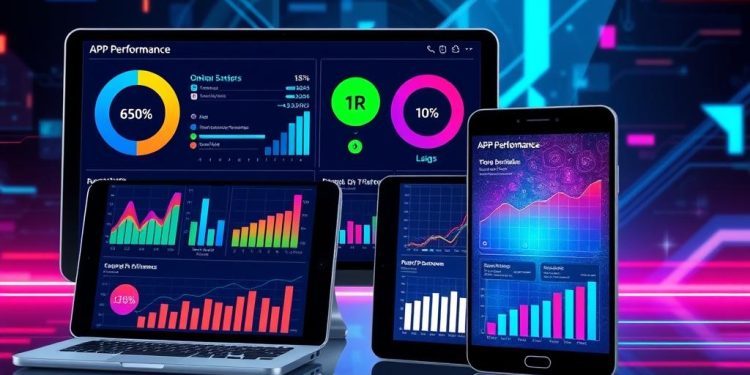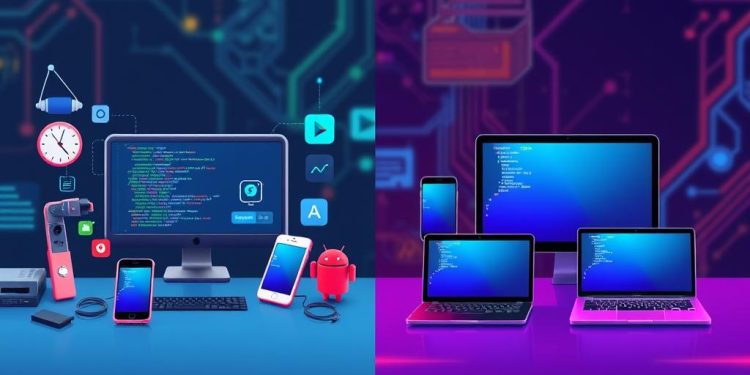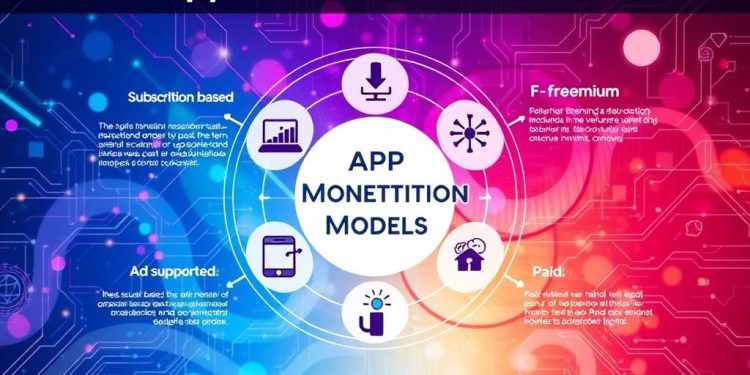The future of app development is gearing up to be a remarkable journey, with significant shifts and advancements on the horizon for 2025. As the mobile app market is projected to reach an impressive $614.40 billion by 2026, staying on top of emerging technologies and mobile app trends is crucial for entrepreneurs and business owners. Understanding these dynamics is essential for maximizing operational efficiency and capturing customer attention effectively.
Innovations such as AI integration, augmented reality (AR), and virtual reality (VR) technologies, alongside the rollout of 5G, are attempting to redefine user experiences and engagement. By mid-2025, it is anticipated that 30.4% of Gen-Z will be utilizing voice technology for shopping at least once per week. This trend, coupled with the expected growth in the global multimodal UI market, which was valued at USD 19.5 billion in 2023 with a CAGR of 16.5%, showcases just how pivotal these emerging technologies will be in shaping app development 2025.
With the rise of AR, where 73% of mobile AR users report high satisfaction during shopping experiences, developers have an unparalleled opportunity to enhance app functionalities. A proactive approach to embracing these exciting mobile app trends will not only keep you competitive but also ensure you provide engaging and satisfying experiences for users in a rapidly evolving market.
Introduction to Mobile App Development Trends
As we approach 2025, the landscape of mobile app development is evolving rapidly in tandem with technological advancements. The global mobile app market, valued at approximately USD 206.85 billion in 2022, is projected to grow at a compound annual growth rate (CAGR) of 13.8% from 2023 to 2030. This growth reflects the significant mobile technology evolution that is influencing user behaviors and preferences.
Current app development trends highlight a pressing demand for seamless digital experiences. Users expect platforms that not only function smoothly but also offer personalized interactions that enhance engagement. With around 8 million apps available across Android and iOS, developers must strive to stand out by adopting cutting-edge technology, including AI integration and no-code development platforms, which are increasingly in demand for their ability to facilitate faster app development and cost reductions.
The growing Internet of Things (IoT) market, which reached $318 billion in 2023, further emphasizes the importance of mobile applications in connecting devices and delivering cohesive user experiences. The rise of IoT technology, coupled with augmented market forecasts, suggests that revenue from related technology is expected to surpass $1.6 trillion by 2025, creating countless opportunities for app developers to innovate.
Finally, the emergence of 5G technology promises to transform user experiences. With projected network speeds up to 100 times faster than 4G and a tenfold decrease in latency, the apps of the future will leverage this connectivity to offer richer, more interactive experiences. Understanding these trends is essential for those looking to thrive in the dynamic world of mobile app development. By embracing these changes, you can position yourself and your business for success in an ever-evolving digital landscape.
AI Integration and Personalized User Experiences
AI integration is becoming a pivotal element in app development, fundamentally transforming how applications engage with users. As your audience continues to grow, now estimated at approximately 6.89 billion smartphone users globally, the demand for personalized experiences intensifies. AI-driven mobile applications utilize machine learning and predictive analytics, setting them apart from traditional apps. The focus now shifts toward creating immersive, tailored interactions that foster user loyalty.
The Role of AI in App Design
The application of AI in design simplifies tasks and enhances interactivity. Developers can automate aspects such as coding, testing, and optimization, which not only reduces human error but also improves overall app quality. Utilizing AI in the development process allows for faster and more efficient cycles, freeing you to concentrate on strategic and creative objectives. Popular tools like TensorFlow Lite and ML Kit empower you to implement intelligent functionalities seamlessly.
Predictive Analytics for Enhanced User Interaction
Predictive analytics plays a crucial role in driving user engagement by accurately forecasting behavior based on previous interactions. Apps like Spotify and Netflix are prime examples, leveraging AI to provide personalized recommendations that significantly boost user satisfaction. The integration of AI enhances customer experiences by enabling real-time adaptations to users’ preferences, ultimately leading to higher engagement rates and improved retention. Companies embracing AI-driven analytics report an increase in customer engagement rates by 50% or more, showcasing the transformative potential of this technology.
Enhanced Connectivity with 5G Technology
The introduction of 5G technology is a game-changer for mobile app development. With its promise of significantly faster download speeds and ultra-low latency, the landscape for network performance and user interactions is transforming. 5G connectivity can potentially deliver speeds up to 100 times faster than 4G, fundamentally changing how users engage with their devices.
Impact of 5G on User Experience
The enhanced user experience provided by 5G technology is particularly noticeable in applications requiring high-speed data and real-time interaction. Streaming high-definition content becomes seamless, allowing for the consumption of 4K and even 8K resolutions without buffering. Multiplayer gaming sees considerable improvements as well, with users experiencing reduced latency that enhances gameplay. Research indicates that about 70% of consumers anticipate that 5G will positively influence their mobile app usage, signifying a strong expectation for advanced features and performance.
Opportunities for Developers in a 5G World
For developers, the rollout of 5G presents exciting opportunities to create smarter applications. By leveraging the enhanced network performance and capabilities, developers can implement IoT integrations, enabling numerous devices to connect effortlessly. The anticipated market growth for 5G technology, expected to reach $668.8 billion by 2026, signifies a bright future. This expansion encourages developers to innovate and adapt, leading to the emergence of applications that utilize real-time data exchange essential for IoT devices, autonomous vehicles, and augmented reality experiences.
With the 5G technology market projected to grow at a compound annual growth rate (CAGR) of 122.3%, the convergence of 5G with emerging technologies such as AI and edge computing is set to further enhance data analytics. This will offer developers the chance to push the boundaries of app functionality and user engagement. The increased reliability and coverage of 5G networks, even in crowded or remote areas, provides unique scenarios for creating innovative applications, making this a time of monumental possibilities in the app development arena.
| Feature | 4G Technology | 5G Technology |
|---|---|---|
| Maximum Speed | 1 Gbps | Up to 10 Gbps |
| Latency | 30-50 ms | As low as 1 ms |
| Peak Download Speed | 100 Mbps | 100x faster |
| Market Growth Projection | N/A | $668.8 billion by 2026 |
| IoT Device Connectivity | Limited Capability | Supports numerous connections simultaneously |
Future of App Development: Embracing Augmented and Virtual Reality
Augmented Reality (AR) and Virtual Reality (VR) are set to revolutionize mobile app development in the coming years. By 2025, AR/VR apps will likely play a significant role in engaging users through immersive experiences. A substantial shift is observed as industries adopt these technologies for various applications.
AR and VR Innovations in Mobile Apps
The advancements in augmented reality innovations are transforming how businesses interact with their customers. Over 70% of organizations are investing in immersive technology, reflecting its importance in contemporary app development. The AR market is anticipated to reach a staggering $198 billion by 2025, showcasing the growing demand for AR capabilities in mobile apps.
With technologies like haptic feedback and eye-tracking, developers can create highly engaging and interactive environments that keep users immersed. Around 86% of users are likely to encounter AR for the first time on their smartphones, emphasizing the need for captivating mobile experiences.
Applications Across Various Industries
Numerous industry applications benefit from AR and VR technologies. In retail, 61% of shoppers show a preference for stores offering AR experiences. Furthermore, virtual try-ons can increase purchase intentions by up to 70%. The education sector is no exception, as the AR education market is projected to reach $5.3 billion by 2024, with interactive learning environments enhancing student retention by more than 30%.
Healthcare professionals emphasize that simulations improve training outcomes, leading to better practices and safety for patients. For instance, Airbus effectively uses AR to train technicians, lowering training costs significantly. Other industries reaping benefits include tourism and real estate, with virtual property tours increasing lead generation by 49%.
The Rise of Progressive Web Apps and No-Code Platforms
Progressive Web Apps (PWAs) and no-code platforms are revolutionizing the app development landscape. Robust yet accessible, these solutions cater to a diverse range of users, from developers to business professionals. The integration of PWAs brings a host of benefits that improve user engagement and satisfaction.
Benefits of Progressive Web Apps (PWAs)
PWAs enhance app accessibility, allowing users to enjoy app-like experiences directly from their web browsers. Here are some key benefits:
- Faster Loading Times: PWAs load quickly, providing a seamless experience even on slower networks.
- Offline Capabilities: Users can access content without requiring continuous internet connectivity, making apps more versatile.
- Cross-Platform Compatibility: PWAs function on various operating systems and devices, reducing the need for multiple versions of an app.
Advantages of No-Code Development for Businesses
No-code platforms empower organizations to create applications without extensive coding knowledge. This democratization of app development brings significant advantages:
- Increased Development Efficiency: Businesses can rapidly develop and deploy applications, reducing time-to-market.
- Cost-Effective Solutions: Lower reliance on technical resources helps to keep project budgets in check.
- Enhanced Collaboration: Teams across departments can contribute ideas and solutions, leading to innovative app features.
The combination of progressive web apps and no-code platforms is gaining momentum. These technologies streamline processes and open doors for companies to innovate while catering to the ever-growing user base that downloaded over 28 billion apps from the Google Play Store in 2021 alone.
| Feature | Progressive Web Apps (PWAs) | No-Code Platforms |
|---|---|---|
| Accessibility | Easily accessible through web browsers | User-friendly interface for non-technical users |
| Development Speed | Rapid loading times and updates | Quick app creation without coding |
| Connectivity | Can function offline | Online collaboration tools |
| Cost | Minimal hosting costs | Lower development costs |
Embracing both PWAs and no-code platforms can significantly enhance your app strategy, meeting the demands of modern users while maintaining operational efficiency.
Conclusion
As you look towards the mobile app future, it’s clear that technological advancements are reshaping the app development landscape. The integration of AI, along with the rise of Progressive Web Apps (PWAs) and 5G connectivity, creates opportunities to enhance user engagement strategies. With 60% of users favoring cross-platform apps and a significant portion indicating they would abandon poorly performing applications, the demand for high-performing, accessible solutions continues to rise.
Embracing these technology trends isn’t just advantageous; it is essential. Your ability to create intuitive, user-centric applications with features like push notifications and offline accessibility will not only meet user expectations but also boost conversion rates significantly. With the mobile applications market projected to exceed $407 billion by 2026, those who adapt to changes in this app development landscape will be in the best position to thrive.
Ultimately, leveraging frameworks like React Native and Flutter for cross-platform development will save time and resources while ensuring a consistent user experience across devices. As we move into 2025, staying attuned to these trends will empower you to create innovative applications that resonate with users, fostering long-term success in a competitive market.







